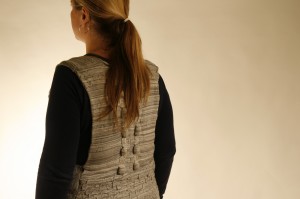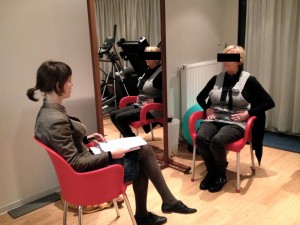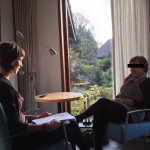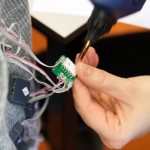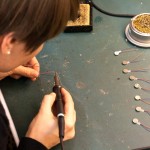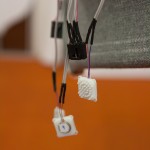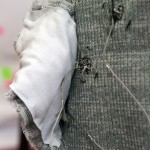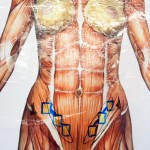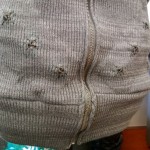In this work we presented the design and implementation of a smart garment named Vibe-ing (see the figures below), and explored the possibilities of embedding vibrotactile actuators into a smart textile.
In order to understand how to design the behavior of such vibrating textile, we implemented and tested two vibrotactile patterns which were applied on the upper back area (addressing the paravertebral muscle area) and front area (addressing the deep abdomen muscles), using vibrotactile actuators embedded in a cardigan looking garment.
The two vibrotactile patterns were designed in accordance with physiotherapy treatments. The first pattern was an upward, sequential pattern starting at the lower back, while the second was a bi-directional pattern starting both at the upper and lower back and ending in the middle (see the figures below). The vibrotactile actuators would start when people touched the touch sensors near their belly in the front of the garment. The intensity in both patterns was increasing gradually (minimum to maximum) from the first to the last vibrotactile actuators in the sequence, sustain for a while, and then decrease each of the vibrotactile intensities gradually from the maximum to the minimum again. Moreover, the aspects of the vibrations we manipulated were order, timing, and intensity of vibrations of the vibrotactile actuators.
We evaluated the prototype qualitatively as the whole concept, i.e., how people perceive vibrations applied directly on the body through an interactive vibrating piece of clothing, and how they interact with the garment. A total of nine targeted participants (five without and four with posture problems) participated in our user studies, consisting of a semi-structured interview, recorded observations, and the writing up of a love- and break-up letter to the garment.
Then we compared the two patterns to disclose the following aspects of vibrations that people recognize: 1) differences in understanding and interpreting the patterns, 2) associations people have with each pattern, and 3) how they experienced each pattern in overall.
The results show that most participants preferred the upward vibrotactile pattern over the bi-directional one. They were able to recognize, predict and describe the upward vibrotactile pattern. It was often mentioned that the bi-directional vibrotactile pattern felt random and out-of-control. For example, one participant told us:
“I prefer the first pattern (i.e. bottom-up) over the second one (i.e. bidirectional). You can feel it building up and it’s much more predictable. The second one seemed kind of random.”
A preference was also expressed for the lower intensity of the upward pattern, compared to the bi-directional one. It was generally recognized that the vibrations were not well detectable when the garment did not fit the participant tight enough. For example, one participant said:
“I only feel the vibrations on my back when I sit or stand against the back of the chair or the wall.”
The finding shows us that predictability and repetitiveness of the pattern should be seriously considered while designing vibrational patterns for use in smart textiles, and intensity and fit of the garment should be included in the design. These results contribute to understanding how to design devices interacting with the users through vibrations, as well as identifying the aspects of vibrations that are important for designing the vibrotactile patterns.
Further, this open platform garment suits well for future design and research work of different interactive vibrotactile patterns for self-care, self-treatment, massages and stimulations. Our garment can offer different possibilities for applications, such as for example: 1) a reminder system for keeping a better posture, 2) a massaging tool for a tension release, 3) a stimulating system of the muscles to be addressed for posture correction, and 4) a feedforward and feedback system for posture correction exercises.
For more information, you can look at our final presentation slides, and you are more than welcome to contact us for any questions or requests.
